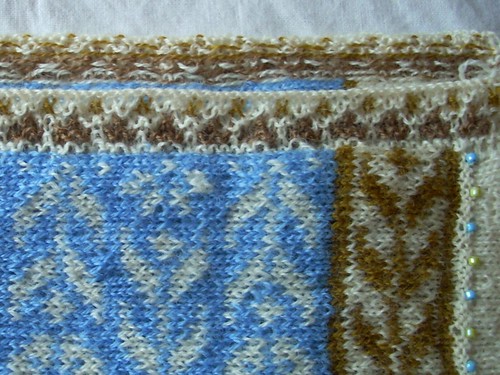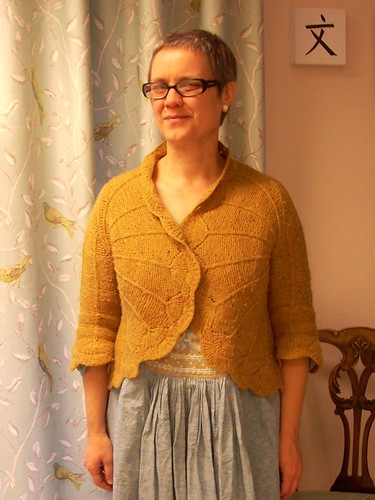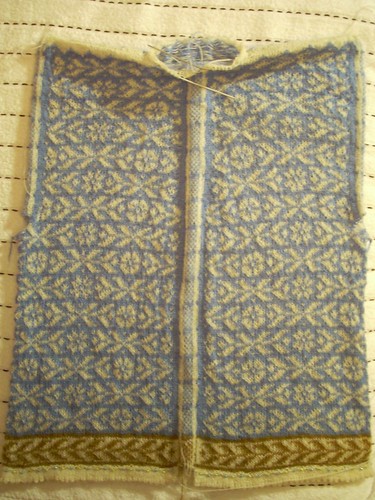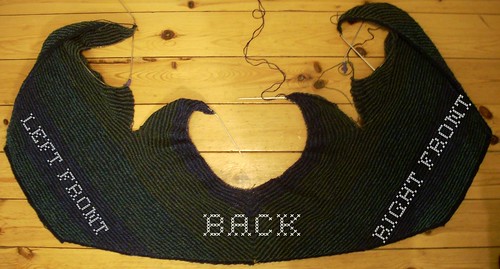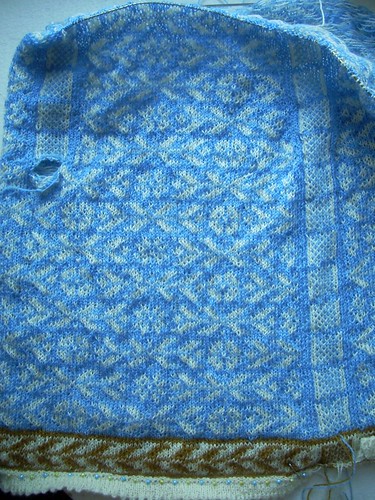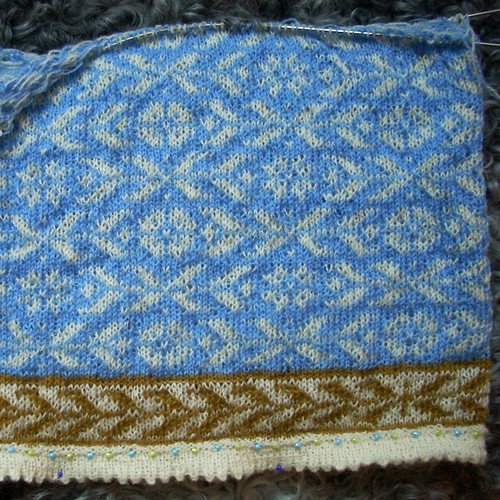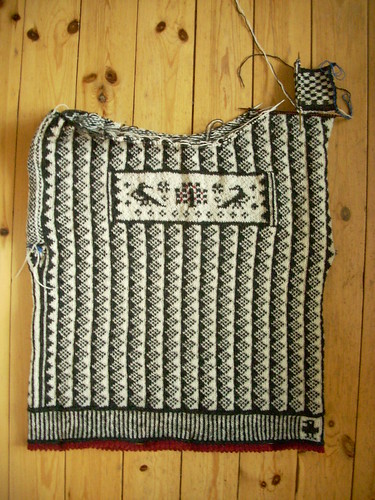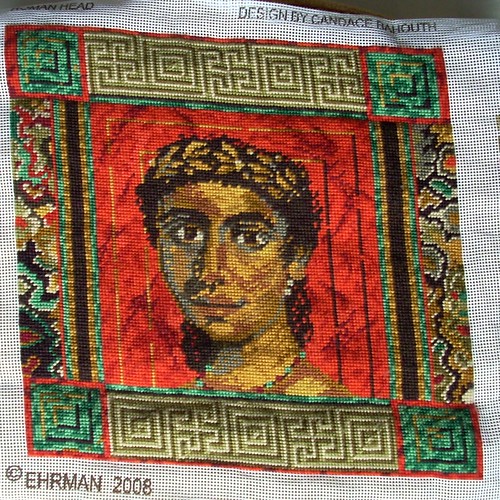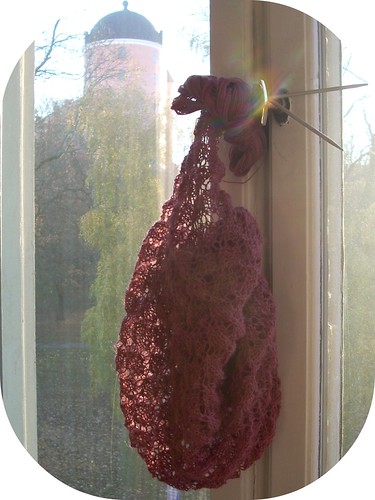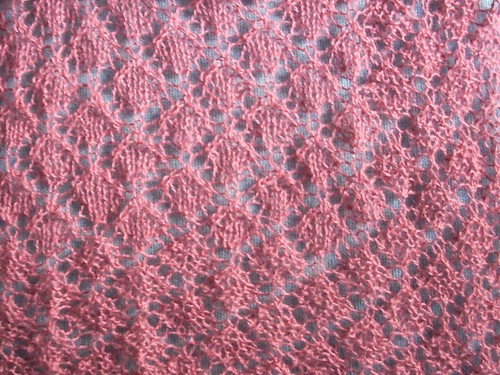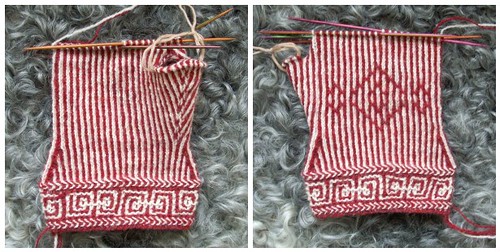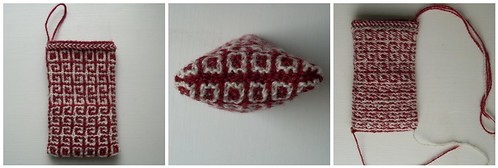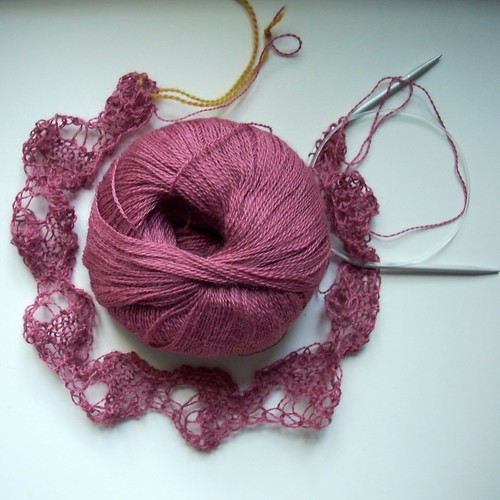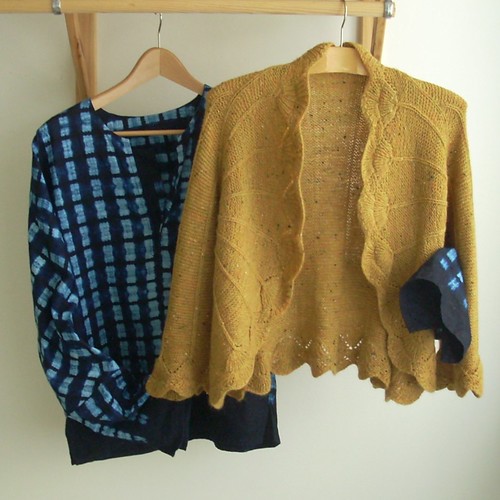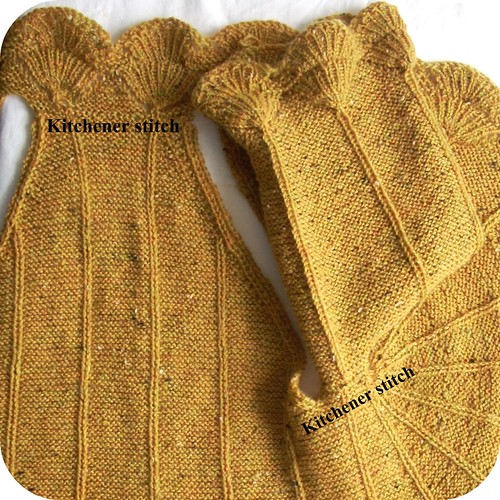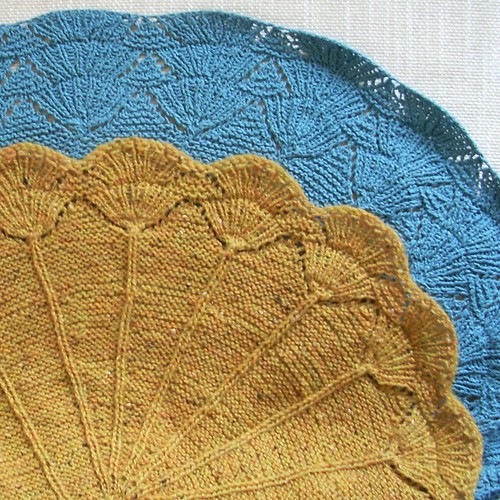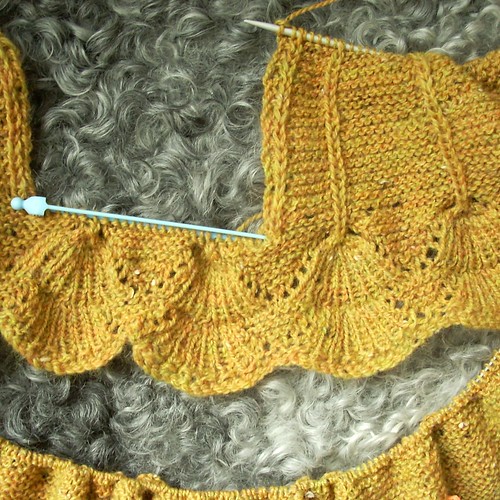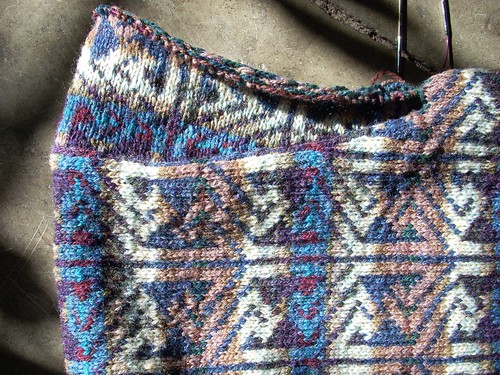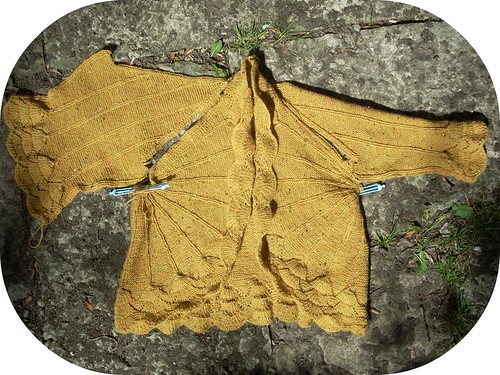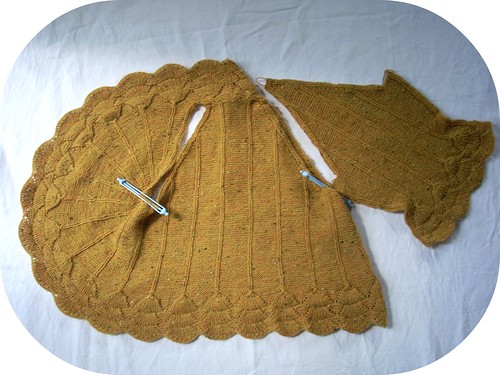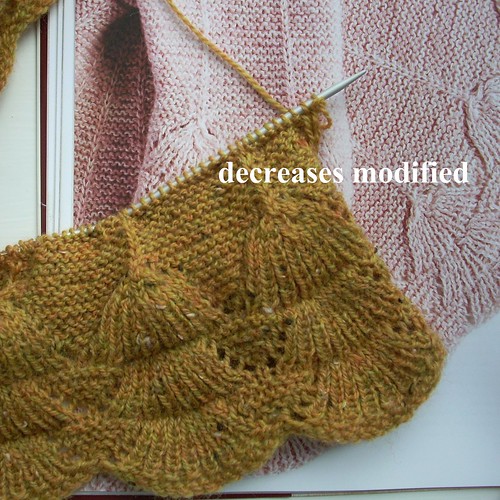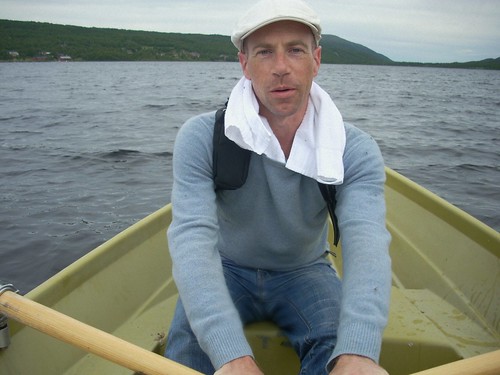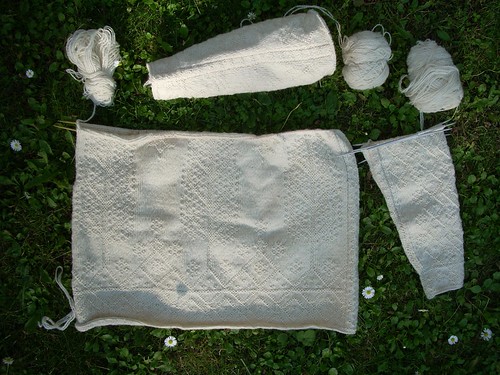I'm testing something I haven't done before, namely stranded garter stitch. This cardigan by Tålamodspåsen inspired me - thank you!
It wasn't difficult, but the wrong-side rows were rather slow to knit as I had to make sure the floats stayed on the wrong side facing me). I think it makes a nice frame.
Next step is picking up stitches to knit the sleeves. I may knit a simpler but similar flower pattern, perhaps just white flowers on blue background. The body pattern repeat is 40 stitches wide, possibly too wide for a sleeve. We'll see.
Tuesday, 27 December 2011
Friday, 23 December 2011
Sigge says "Happy holidays!"
Wednesday, 21 December 2011
Contagion
In April I suddenly discovered my new sweater matched the kitchen curtains at work. It still makes me smile - although come to think of it I probably haven't worn that particular sweater to work since then.
Today my Viften-clad colleague suddenly discovered she matched the curtains in her office! :-D
Today my Viften-clad colleague suddenly discovered she matched the curtains in her office! :-D
Pre-blocking
The steeks are waiting to be cut. I have secured them in two ways. First with chain stitch - I usually do that with a crochet hook (En till once showed me how to), but the few hooks I have were too big. To be on the safe side (haven't worked with this yarn before) I also wetted the steeks and rubbed them gently to make them felt.
It occurred to me I might as well pre-block it, not that carefully but enough to get a better idea of how the pattern will turn out. The blue looks too dull in this photo, but I didn't have the patience to wait for daylight. Not that you can be certain there will be any this time of the year.
It occurred to me I might as well pre-block it, not that carefully but enough to get a better idea of how the pattern will turn out. The blue looks too dull in this photo, but I didn't have the patience to wait for daylight. Not that you can be certain there will be any this time of the year.
Monday, 19 December 2011
Vest construction
Hanne Falkenberg's "Blues" vest is really fascinating!
You knit the two fronts diagonally towards the back centre and then join the two fronts to knit the back across them. I guess I shouldn't reveal more details than that as I don't own the copyright although it's tempting.
However, it's quite safe to reveal that I discovered I had made a mistake knitting the the first front section, ending up with a few stitches fewer than I was supposed to - and corrected it by adding a few rows with increases and making the same mistake on purpose while knitting the second one.
It saved a lot of time and will hardly make any difference when it comes to size; the important thing must be having the same number of stitches when it's time to join the sections.
The construction and colour changes make this a rewarding project to knit, but I do prefer more pattern, to tell you the truth. I accidentally typed "yell you the truth" first! Must be the season ;-)
You knit the two fronts diagonally towards the back centre and then join the two fronts to knit the back across them. I guess I shouldn't reveal more details than that as I don't own the copyright although it's tempting.
However, it's quite safe to reveal that I discovered I had made a mistake knitting the the first front section, ending up with a few stitches fewer than I was supposed to - and corrected it by adding a few rows with increases and making the same mistake on purpose while knitting the second one.
It saved a lot of time and will hardly make any difference when it comes to size; the important thing must be having the same number of stitches when it's time to join the sections.
The construction and colour changes make this a rewarding project to knit, but I do prefer more pattern, to tell you the truth. I accidentally typed "yell you the truth" first! Must be the season ;-)
Monday, 12 December 2011
Cardigan progress
This cardigan will be very light: so far I've used only 100 grams!
My plan is to knit two more horizontal borders and then change patterns for the shoulders, probably reusing this idea in some way.White background with small blue shapes and/or pearls, perhaps?
I think the steeks look rather nice, not so nice it's a pity to cut them, but perhaps they can be used as an idea for a future pattern.
My plan is to knit two more horizontal borders and then change patterns for the shoulders, probably reusing this idea in some way.White background with small blue shapes and/or pearls, perhaps?
I think the steeks look rather nice, not so nice it's a pity to cut them, but perhaps they can be used as an idea for a future pattern.
Sunday, 4 December 2011
Fair trade
Look what I got in advance for the cardigan I'm making! Love all four of them, but possibly the skaters best. Natasha is a truly versatile artist, and you can see some of her works at Uppsala konstmuseum (in the castle) until 22 January.
Thursday, 1 December 2011
Cardigan modifications
The cardigan I am making for a colleague is growing fairly quickly in spite of the thin needles (never used 2 mm for a sweater before) and I'm happy with my modifications now that I see how the turn out:
Thanks for encouraging comments on my previous post! In particular I took christinelaennec's words about supporting economy to heart :) Guess what I did yesterday? Right. Some more support by purchasing a Hanne Falkenland vest kit I've had my eyes on for quite a while. Those Danes are incredible - such an eye for details and ingenious constructions. The yarn is quite lovely too: a strand of indigo cotton wrapped around a strand of lamb's wool.
- Single strands and 2 mm needles instead of double strands and 3 mm.
- Green and blue pears near the picot edge instead of yellow pearls among the mustard leaves.
- Simpler, straighter, mustard leaves (to make it easier to knit).
- Mustard leaves going in opposite directions from the centre of the back section (see right corner in photo above) instead of travelling round in a circle; I want the leaves to meet in front.
- Main pattern also simpler with straighter leaves and the big flowers turned into smaller ones alternating with stars, echoing a sweater I knitted in the late 90s.
Thanks for encouraging comments on my previous post! In particular I took christinelaennec's words about supporting economy to heart :) Guess what I did yesterday? Right. Some more support by purchasing a Hanne Falkenland vest kit I've had my eyes on for quite a while. Those Danes are incredible - such an eye for details and ingenious constructions. The yarn is quite lovely too: a strand of indigo cotton wrapped around a strand of lamb's wool.
Sunday, 27 November 2011
Adding even more to my stash
What to do when you can't decide how to go on with your sweater(s)? Well, you can always cast on to make another one!
Even though (useful expression!) I shouldn't (also good!) really (one more!) keep adding to my stash before I've knitted up more of it, I just couldn't resist some of the many gorgeous things I found at GarnGalleriet.
To be honest, I even told myself it was my duty to get knitting-related things for what I earned leading knitting workshops. And I bought the argument without making a fuss. Here's what I got:
Solveig Hisdal's "Wedding cardigan" may be my top favourite design from her book Poetry in Stitches. I'm modifying the pattern in different ways, though, mainly to avoid long floats with both strands. Just one is ok, but two is too time-consuming to catch.
I recently found pretty Japanese pears on sale at Litet nystan and decided to use them in this project. Instead of the original's yellow pearls among the yellow leaves, I've added a row of green and blue pearls near the picot edge.
The yarn is thin, and the instructions in the kit tell you to use two strands. Instead, I'm using one strand and thinner needles (2 mm/US 0) - and more stitches. I did this to make the cardigan lighter and because I believe four strands in all might make it too warm to wear very often. And simply to see if it works!
PS I recently started and finished a vest with some yarn bought a few years ago, which shows I am capable of using my stash - and which means it's ok to add to it whenever I like ;-)
Even though (useful expression!) I shouldn't (also good!) really (one more!) keep adding to my stash before I've knitted up more of it, I just couldn't resist some of the many gorgeous things I found at GarnGalleriet.
To be honest, I even told myself it was my duty to get knitting-related things for what I earned leading knitting workshops. And I bought the argument without making a fuss. Here's what I got:
 |
| A pattern book, 5 hanks of blue wool, 3 hanks of white cashmere, 5 hanks of green wool, a cardigan kit |
Solveig Hisdal's "Wedding cardigan" may be my top favourite design from her book Poetry in Stitches. I'm modifying the pattern in different ways, though, mainly to avoid long floats with both strands. Just one is ok, but two is too time-consuming to catch.
I recently found pretty Japanese pears on sale at Litet nystan and decided to use them in this project. Instead of the original's yellow pearls among the yellow leaves, I've added a row of green and blue pearls near the picot edge.
The yarn is thin, and the instructions in the kit tell you to use two strands. Instead, I'm using one strand and thinner needles (2 mm/US 0) - and more stitches. I did this to make the cardigan lighter and because I believe four strands in all might make it too warm to wear very often. And simply to see if it works!
PS I recently started and finished a vest with some yarn bought a few years ago, which shows I am capable of using my stash - and which means it's ok to add to it whenever I like ;-)
Monday, 14 November 2011
Sweater progress
Back and front done and armhole steeks cut; next step will be joining the shoulders.
Knowing roughly but not exactly what I want to achieve I've been thinking, testing, ripping out, reknitting, rethinking and so on and so forth for a couple of weeks. I've practically made up my mind now:
To be continued...
Thanks for kind and flattering words about my needlework! :)
Carolina asked about blocking and using a frame when stitching. I have thought about using frames to make blocking easer, but like the freedom without a frame: easier both to turn while stitching and to carry around. (I sometimes stitch on trains and buses.) Blocking it to get the right shape can be quite difficult, thouhg, but I guess you can see it as good exercise.
Knowing roughly but not exactly what I want to achieve I've been thinking, testing, ripping out, reknitting, rethinking and so on and so forth for a couple of weeks. I've practically made up my mind now:
- Keeping the original design's black and white square pattern.
- Knitting separate saddles instead of finishing the back and front parts with the squares.
- Skipping a horizontal border pattern between main pattern and squares.
- Incorporating the saddle live stitches from the provisional cast on and the last row when knitting the sleeve and neckband.
To be continued...
Thanks for kind and flattering words about my needlework! :)
Carolina asked about blocking and using a frame when stitching. I have thought about using frames to make blocking easer, but like the freedom without a frame: easier both to turn while stitching and to carry around. (I sometimes stitch on trains and buses.) Blocking it to get the right shape can be quite difficult, thouhg, but I guess you can see it as good exercise.
Wednesday, 2 November 2011
Asplund stitches
A few years ago I did quite a lot of needlepoint and cross-stitch (Flickr set here) but it wasn't until I came across this needlepoint design by Candace Bahouth at Wincent that I returned to stitching.
I completed the last stitch half an hour ago, and as you can see it will have to be blocked into a square shape. It was a lot of fun to make with all the different kinds of patterns, and I love working with this orgy of colours - you just couldn't knit it, unless you don't mind knitwear about 5 centimetres thick. I haven't decided how to use it, but might make a cushion.
I completed the last stitch half an hour ago, and as you can see it will have to be blocked into a square shape. It was a lot of fun to make with all the different kinds of patterns, and I love working with this orgy of colours - you just couldn't knit it, unless you don't mind knitwear about 5 centimetres thick. I haven't decided how to use it, but might make a cushion.
Tuesday, 1 November 2011
Wrap and sweater progress
Bressay-ish hap wrap by Sharon Miller: I've finished the centre section, picked up stitches around it and started knitting the border - and it looks as if I'm trying to knit a brain! Or an udder.
Thorsten fiskares tröja (Fisherman Thorsten's sweater) by Celia B. Dackenberg: I'm getting closer to the shoulders. The original has a similar square in front, but with initials and a year. I wanted some kind of picture instead and found a bird in a book by Britta Johanson, modified it slightly and mirrored it, put a kind of tree in the middle and added some of the picot edge red.
About the edge: you're quite right, Ron - there are two purl rows above the join. I've found it helps keeping it from folding outwards.
 |
| Thorsten fiskares tröja |
Thursday, 27 October 2011
The Pale Cast of Thought
About a month and a half ago I started knitting Sharon Miller's "Bressay Hap Wrap", a free pattern from Rowan. I do like the design, but should have read the instructions carefully before casting on. After some consideration I have decided to frog what I've made and modify both the construction and the pattern. Here are the two main modifications:
Original design: four outer borders knitted separately with their corners sewn together.
Modified version: stitches for outer borders picked up around the centre section and knitted in the round to avoid seams.
Original design: all garter stitch.
Modified version: a combination of garter stitch and stocking stitch, partly for variation, partly to show and compare the difference in a single garment. (I'm bringing this project to Saturday's lace knitting workshop at GarnGalleriet.)
Encouraged by all the positive comments on my previous post I returned to Litet nystan to add even more to my stash of Shetlandsuld. Thank you! :-)
Ron and Francesca asked about Shetlandsuld, how it compares to Jamieson & Smith and Isager's Tvinni. I have actually never worked with J & S, so I don't know. I'd say Shetlandsuld is slightly rough to work with (which I like - not very fond of slippery yarns) but a lot softer after washing and blocking. It is quite similar to Tvinni, but thicker.
Ron also asked about the picot edge. First, I knit a few rows of stocking stitch; next a "knit two together, yarn over" row (even number of stitches); a few more rows of stocking stitch.
It is possible to fold and sew it in place, but I prefer knitting it in place through the cast-on loops: not only does it look neater to me, but it is also over and done with. I knit through every second loop, the ones about the yarn-over holes - I have found that doing so accentuates the points.
Original design: four outer borders knitted separately with their corners sewn together.
Modified version: stitches for outer borders picked up around the centre section and knitted in the round to avoid seams.
Original design: all garter stitch.
Modified version: a combination of garter stitch and stocking stitch, partly for variation, partly to show and compare the difference in a single garment. (I'm bringing this project to Saturday's lace knitting workshop at GarnGalleriet.)
Encouraged by all the positive comments on my previous post I returned to Litet nystan to add even more to my stash of Shetlandsuld. Thank you! :-)
Ron and Francesca asked about Shetlandsuld, how it compares to Jamieson & Smith and Isager's Tvinni. I have actually never worked with J & S, so I don't know. I'd say Shetlandsuld is slightly rough to work with (which I like - not very fond of slippery yarns) but a lot softer after washing and blocking. It is quite similar to Tvinni, but thicker.
Ron also asked about the picot edge. First, I knit a few rows of stocking stitch; next a "knit two together, yarn over" row (even number of stitches); a few more rows of stocking stitch.
It is possible to fold and sew it in place, but I prefer knitting it in place through the cast-on loops: not only does it look neater to me, but it is also over and done with. I knit through every second loop, the ones about the yarn-over holes - I have found that doing so accentuates the points.
 |
| knitting the picot edge in place |
Thursday, 13 October 2011
Spoiling oneself rotten
Well, well... I decided to make an another exception to trying not to buy more yarn before using up a kilo or two of my stash - and instead have actually added about a kilo and a half. Good boy!
A sale that coincided with getting my salary for the twined knitting workshop resulted in twelve hanks of Shetlandsuld, and then there's irresistible wool-silk lace yarn that I got thanks to Good girl Francesca. Grazie mille! I've used this yarn, Jaggerspun Zephyr, only once before and have dreamt of getting my hands on it again since then.
 What else? I've cast on yet another project, yet another sweater. After all, sweaters are my favourite thing to knit, stranded colourwork is my favourite technique, and this particular pattern is from a favourite book: "Ylle & bläck" (wool and ink) by Celia B. Dackenberg.
What else? I've cast on yet another project, yet another sweater. After all, sweaters are my favourite thing to knit, stranded colourwork is my favourite technique, and this particular pattern is from a favourite book: "Ylle & bläck" (wool and ink) by Celia B. Dackenberg.
This gem of a book is a collection of essays about writers (mainly poets) and knitting, sweaters they wear in photos, knitting in their writing et cetera. Some designs are reconstructions of real sweaters, others are knitted interpretations of fictional garments. The sweater I'm knitting is dedicated to fisherman Thorsten, main character in a work by 18th century poet Erik Johan Stagnelius.
Modifications
A sale that coincided with getting my salary for the twined knitting workshop resulted in twelve hanks of Shetlandsuld, and then there's irresistible wool-silk lace yarn that I got thanks to Good girl Francesca. Grazie mille! I've used this yarn, Jaggerspun Zephyr, only once before and have dreamt of getting my hands on it again since then.
 What else? I've cast on yet another project, yet another sweater. After all, sweaters are my favourite thing to knit, stranded colourwork is my favourite technique, and this particular pattern is from a favourite book: "Ylle & bläck" (wool and ink) by Celia B. Dackenberg.
What else? I've cast on yet another project, yet another sweater. After all, sweaters are my favourite thing to knit, stranded colourwork is my favourite technique, and this particular pattern is from a favourite book: "Ylle & bläck" (wool and ink) by Celia B. Dackenberg. This gem of a book is a collection of essays about writers (mainly poets) and knitting, sweaters they wear in photos, knitting in their writing et cetera. Some designs are reconstructions of real sweaters, others are knitted interpretations of fictional garments. The sweater I'm knitting is dedicated to fisherman Thorsten, main character in a work by 18th century poet Erik Johan Stagnelius.
Modifications
- Bird added (from a mitten in "Knitting in the Nordic Tradition" by Vibeke Lind).
- Straight red edge changed to a picot edge.
- A narrow horizontal border pattern between stripes and main pattern skipped (because I didn't want the vertical lines interrupted).
 |
| My photogenic neighbours |
Thursday, 6 October 2011
Lost & found; right &wrong
Shortcuts are great in many ways, but it is a major disadvantage that your knitting might get caught by twigs without your noticing it. Fortunately, a neighbour found my twined mitten among the lilac shrubs after it had been missing for days and I had almost given up hope.
I started it for my twined knitting workshop to show some patterns you can make with two colours. This project also shows the pattern effect you achieve when you place the increases for the thumb gusset in the middle of it: the two colours almost look braided.
Speaking of braids, one of the participants asked me about knitting a braid in a contrast colour, when to join it in and for how many rows to keep it.
I said you have to prepare for the braid by joining in the new colour the row before the braid - and was later ashamed to realize I had done exactly the opposite of what I had been preaching. More than once I told the group I didn't like right and wrong, the idea that you have to do things in a certain way because that's how they are done.
I also quoted Dödergök: "Traditions are there to enrich my knitting, not to restrict it." I love traditional knitting and have learnt a lot from knitting old patterns and trying to master different techniques, but after all, what is regarded as traditional now was once new. And quite possibly, perhaps certainly, regarded as wrong by some.
Of course you don't have to join in the new colour the row before you make the braid; it will just look different. I'm working on a swatch testing various combinations.
All the braids have exactly the same structure (if they were all white they would be identical) but turn out completly different depending on when I add a colour, for how many rows I keep it and which row(s). These are about half of the combinations I can think of, and it's quite exciting seeing them take shape! And I haven't even added a third colour...
Which one is right then? Well, I'd say the one you want to make is the right one.
Last but not least, Åsa likes her "Viften" cardigan. I think it's a great colour for her!
I started it for my twined knitting workshop to show some patterns you can make with two colours. This project also shows the pattern effect you achieve when you place the increases for the thumb gusset in the middle of it: the two colours almost look braided.
Speaking of braids, one of the participants asked me about knitting a braid in a contrast colour, when to join it in and for how many rows to keep it.
 |
| Twined braids |
I also quoted Dödergök: "Traditions are there to enrich my knitting, not to restrict it." I love traditional knitting and have learnt a lot from knitting old patterns and trying to master different techniques, but after all, what is regarded as traditional now was once new. And quite possibly, perhaps certainly, regarded as wrong by some.
Of course you don't have to join in the new colour the row before you make the braid; it will just look different. I'm working on a swatch testing various combinations.
All the braids have exactly the same structure (if they were all white they would be identical) but turn out completly different depending on when I add a colour, for how many rows I keep it and which row(s). These are about half of the combinations I can think of, and it's quite exciting seeing them take shape! And I haven't even added a third colour...
Which one is right then? Well, I'd say the one you want to make is the right one.
Last but not least, Åsa likes her "Viften" cardigan. I think it's a great colour for her!
Thursday, 22 September 2011
Twined knitting with two colours
I do like swatches, but it's also nice to combine swatching with making something you can use.
The other day I saw super knitter Tålamodspåsen's phone case and thought I'd make one for myself to test a couple of pattern ideas for twined knitting.
For easy comparison I like having different versions of the same idea in a swatch, in this case a pattern with knit stitches and then with both knit and purl stitches. Not only do they look and feel slightly different, the one with purls is thicker too.
Twined knitting with two colours looks a bit like mosaic knitting, but there are major differences. In mosaic knitting you knit with one colour at a time and slip stitches to make a pattern; in twined knitting you knit with both colours and cover stitches with the strand you don't knit with to make a pattern. I haven't knitted much mosaic knitting, but it seems to me it tends to curve (depending on the pattern) in a way twined knitting doesn't. Not that it's a bad thing necessarily - I can see how it could be an effect you'd want to achieve.
Edited to add: how I wish I could draw like Mattias!
The other day I saw super knitter Tålamodspåsen's phone case and thought I'd make one for myself to test a couple of pattern ideas for twined knitting.
For easy comparison I like having different versions of the same idea in a swatch, in this case a pattern with knit stitches and then with both knit and purl stitches. Not only do they look and feel slightly different, the one with purls is thicker too.
Twined knitting with two colours looks a bit like mosaic knitting, but there are major differences. In mosaic knitting you knit with one colour at a time and slip stitches to make a pattern; in twined knitting you knit with both colours and cover stitches with the strand you don't knit with to make a pattern. I haven't knitted much mosaic knitting, but it seems to me it tends to curve (depending on the pattern) in a way twined knitting doesn't. Not that it's a bad thing necessarily - I can see how it could be an effect you'd want to achieve.
 |
| All the twisting makes it necessary to unwind the two strands every now and then. Having just one ball of yarn makes it easier: you just let it hang in the air. |
Edited to add: how I wish I could draw like Mattias!
Tuesday, 13 September 2011
Lace knitting
Here's my new lace project, "Bressay Hap Wrap" by Sharon Miller, a free pattern from Rowan. The yarn is also from Rowan, a blend of merino and alpaca called Fine Lace and I got it from Wincent in Stockholm. Thanks, Eva!
Speaking of lace knitting, as mentioned in a previous post I will be leading a couple of workshops with GarnGalleriet in Uppsala. The dates are settled, October 16 (all day) and 29 (afternoon). For more information, write to info@garngalleriet.se
(It feels rather silly writing this in English - as if anyone would even consider travelling from another country for a workshop - but changing languages in the middle of a blog post would also feel silly!)
But first a twined knitting workshop at Litet Nystan to warm up! I'm having fun preparing material and sort of relearning the techniques (studying what my fingers to more or less automatically by now) to be able to explain them well.
Speaking of lace knitting, as mentioned in a previous post I will be leading a couple of workshops with GarnGalleriet in Uppsala. The dates are settled, October 16 (all day) and 29 (afternoon). For more information, write to info@garngalleriet.se
(It feels rather silly writing this in English - as if anyone would even consider travelling from another country for a workshop - but changing languages in the middle of a blog post would also feel silly!)
But first a twined knitting workshop at Litet Nystan to warm up! I'm having fun preparing material and sort of relearning the techniques (studying what my fingers to more or less automatically by now) to be able to explain them well.
 |
| "Bressay Hap Wrap" by Sharon Miller |
Tuesday, 6 September 2011
And they lived happily ever after
Here's the shirt my colleague made for me and the cardigan I made for her. We'd like to see this as proof we're so good at co-operation that our salaries should be raised dramatically!
Sunday, 4 September 2011
Grafting "Viften/The Fan"
I like avoiding seams as far as possible, not only because I don't like sewing, but also for comfort: why have welts at the back of the neck and under the arms if you can avoid them?
For this project I have learnt how to graft garter stitch. I have grafted stocking stitch before ("Kitchener stitch") and was happily surprised garter stitch was easier. Excellent instructions here. (Of course, this is a form of sewing too, but I don't mind it that much when the resulting seam looks like knitting.)
I have been asked how I modified the decreases knitting the border.
Here are the four kinds I've used:
 1. "knit two together" for decrease to slant to the right.
1. "knit two together" for decrease to slant to the right.
2. "slip one as if to knit, slip one more as if to knit, put both back on left needle and knit them together through back loops" for decrease to slant to the left.
3. "slip one as if to knit, slip one more as if to knit,knit one, pass slipped stitches over the stitch just knitted" for a double decrease when the middle stitch is top of a purl ladder (to avoid a purl on top). You could simply knit three together (the knit stitch to the left would end up on top instead of the one to the right) but that decrease feels slightly more like a bump in my picky fingers' opinion.
4. "slip two together as if to knit, knit one, pass slipped stitches over the stitch just knitted" for a double decrease where the middle stitch end up on top of the other two.
For this project I have learnt how to graft garter stitch. I have grafted stocking stitch before ("Kitchener stitch") and was happily surprised garter stitch was easier. Excellent instructions here. (Of course, this is a form of sewing too, but I don't mind it that much when the resulting seam looks like knitting.)
I have been asked how I modified the decreases knitting the border.
Here are the four kinds I've used:
 1. "knit two together" for decrease to slant to the right.
1. "knit two together" for decrease to slant to the right.2. "slip one as if to knit, slip one more as if to knit, put both back on left needle and knit them together through back loops" for decrease to slant to the left.
3. "slip one as if to knit, slip one more as if to knit,knit one, pass slipped stitches over the stitch just knitted" for a double decrease when the middle stitch is top of a purl ladder (to avoid a purl on top). You could simply knit three together (the knit stitch to the left would end up on top instead of the one to the right) but that decrease feels slightly more like a bump in my picky fingers' opinion.
4. "slip two together as if to knit, knit one, pass slipped stitches over the stitch just knitted" for a double decrease where the middle stitch end up on top of the other two.
Thursday, 1 September 2011
Same but different
Here's the first "Viften/The Fan" I knitted a couple of years ago (blue bourette silk) and the third one I'm currently making (yellow merino wool) for comparison. There are a few differences apart from colour and fibre:
1. I decided to cast on a lot more loosely for a more pronounced scalloped edge.
2. There is an extra row (purls on the right side) to make the edge curl slightly.
3. Border pattern two repeats instead of three (to save yarn to be on the safe side).
There are sleeve modifications too:
1. Border five repeats wide instead of four to make the sleeves less narrow. This will make modified raglan shaping necessary, but I've decided to wait with calculations until I get there.
2. Sleeves knitted in the round to avoid a seam. When I get to the armholes I will start knitting back and forth for the raglan shape, though.
3. The instructions allow you to choose between short and long sleeves, but these will be medium length instead (like the previous one I made).
What else?
I'm quite excited about a twined knitting workshop I will be leading at Litet nystan in a few weeks! Equally exciting is planning a couple of lace knitting workshops with GarnGalleriet in Uppsala in October - will write more details about that when we've made more decisions.
1. I decided to cast on a lot more loosely for a more pronounced scalloped edge.
2. There is an extra row (purls on the right side) to make the edge curl slightly.
3. Border pattern two repeats instead of three (to save yarn to be on the safe side).
There are sleeve modifications too:
1. Border five repeats wide instead of four to make the sleeves less narrow. This will make modified raglan shaping necessary, but I've decided to wait with calculations until I get there.
2. Sleeves knitted in the round to avoid a seam. When I get to the armholes I will start knitting back and forth for the raglan shape, though.
3. The instructions allow you to choose between short and long sleeves, but these will be medium length instead (like the previous one I made).
What else?
I'm quite excited about a twined knitting workshop I will be leading at Litet nystan in a few weeks! Equally exciting is planning a couple of lace knitting workshops with GarnGalleriet in Uppsala in October - will write more details about that when we've made more decisions.
Thursday, 25 August 2011
Viften/The Fan no 3
I've surprised myself by casting on a project practically identical to one I just cast off. Fair trade: I'm making this one for a colleague who's sewing me a shirt.
Any new modifications?
Anticipation...
Yes!
1. Border knitted in the round to avoid a seam at the back of the neck.
2. Border two repeats (see photo above) instead of three (photo here), partly simply for the sake of variation but primarily to save yarn. Each of the 28 repeats grows from 16 to 24 stitches wide. I think it looks nice this way too, and there's no need to worry about running out of yarn - and a couple of centimetres shorter will hardly make a difference.
Now over to some questions and comments on my previous post.
Ron: I picked up stitches around the armohole with a dark strand and wrapped with dark strands to keep the wraps from showing too much. (After discovering light wraps stand out a lot more.) I believe Alba is a Gaelic word for Scotland. (Incidentally, it is also Latin for "white" which is hardly the first thing that comes to mind when you see Starmore's design!)
Ann: it's difficult to explain why I had to turn it upside down, but I'll give it a try! The pattern itself is symmetrical, in a way that if knitted in two colours only there wouldn't be a problem. The colour sequences are symmetrical in a different way, though: a particular colour would be at the beginning of a pattern shape instead of at the end, for example. (Perhaps it wouldn't show much, but I didn't want to risk it. And it was a challenge I liked.)
Knitgoddess: I ordered a kit from Virtual Yarns. The colours are not identical to the ones in the book (and I believe the yarn is slightly thicker too) but at least they're Alice Starmore's own choice. Where can I see your "Pacific" sweater? Ravelry?
Any new modifications?
Anticipation...
Yes!
1. Border knitted in the round to avoid a seam at the back of the neck.
2. Border two repeats (see photo above) instead of three (photo here), partly simply for the sake of variation but primarily to save yarn. Each of the 28 repeats grows from 16 to 24 stitches wide. I think it looks nice this way too, and there's no need to worry about running out of yarn - and a couple of centimetres shorter will hardly make a difference.
Now over to some questions and comments on my previous post.
Ron: I picked up stitches around the armohole with a dark strand and wrapped with dark strands to keep the wraps from showing too much. (After discovering light wraps stand out a lot more.) I believe Alba is a Gaelic word for Scotland. (Incidentally, it is also Latin for "white" which is hardly the first thing that comes to mind when you see Starmore's design!)
Ann: it's difficult to explain why I had to turn it upside down, but I'll give it a try! The pattern itself is symmetrical, in a way that if knitted in two colours only there wouldn't be a problem. The colour sequences are symmetrical in a different way, though: a particular colour would be at the beginning of a pattern shape instead of at the end, for example. (Perhaps it wouldn't show much, but I didn't want to risk it. And it was a challenge I liked.)
Knitgoddess: I ordered a kit from Virtual Yarns. The colours are not identical to the ones in the book (and I believe the yarn is slightly thicker too) but at least they're Alice Starmore's own choice. Where can I see your "Pacific" sweater? Ravelry?
Sunday, 14 August 2011
"Alba" progress
First of all, thanks for all your birthday wishes and lovely comments on my previous post!
Back to work after my summer vacation I've had far less time to knit the past week, but have made progress with "Alba" that I thought I'd share.
The sleeves are modified in three ways:
1. Backand front sections shaped instead of straight from armhole to shoulder to avoid excess fabric under the arm.
2. Sleeve caps made using short rows (see earlier post) also to avoid excess fabric.
3. Pattern turned upside down for shapes and colour sequences to blend better where sleeve meets shoulder.
Now off to finish the second sleeve cap while I remember how to make it identical!
Back to work after my summer vacation I've had far less time to knit the past week, but have made progress with "Alba" that I thought I'd share.
The sleeves are modified in three ways:
1. Backand front sections shaped instead of straight from armhole to shoulder to avoid excess fabric under the arm.
2. Sleeve caps made using short rows (see earlier post) also to avoid excess fabric.
3. Pattern turned upside down for shapes and colour sequences to blend better where sleeve meets shoulder.
 |
| "Alba" shoulder |
Now off to finish the second sleeve cap while I remember how to make it identical!
Monday, 8 August 2011
Isager's Viften/The Fan finished
Seamed, blocked and handed over to Åsa. The size was right for her, and she was happy with the modified sleeve length! Turned inside out it looks like this.
I'm quite obsessed with Alice Starmore's "Alba", knitting like mad. (A phenomenon not particularly uncommon...) I've modified it by shaping the armholes to make it a little bit less too big (see earlier post) and will modifiy the neck too; I want it slightly deeper and narrower than the original design. How I wish the photo captured the colours! The gorgeous hints of different greens are lost, for example.
Today is the last day of my summer vacation, so I'd better make full knitting use of it. Actually, it's my birthday too: I'm going to treat myself to extra extra knitting time! How old? 38. Really good age - my best so far!
I'm quite obsessed with Alice Starmore's "Alba", knitting like mad. (A phenomenon not particularly uncommon...) I've modified it by shaping the armholes to make it a little bit less too big (see earlier post) and will modifiy the neck too; I want it slightly deeper and narrower than the original design. How I wish the photo captured the colours! The gorgeous hints of different greens are lost, for example.
 |
| Alice Starmore's "Alba" |
Wednesday, 3 August 2011
Isager's Viften/The Fan
Only seaming, darning and blocking left - and handing over to recipient, of course!
Yarn: BC Lucca Fino Tweed, 300 grams.
Needles: 3½ mm (US 4).
Modifications in short:
If I make it a third time I will knit the border in the round to avoid a welt where the edges are seamed.
Yarn: BC Lucca Fino Tweed, 300 grams.
Needles: 3½ mm (US 4).
Modifications in short:
- back and front sections knitted together instead of separately
- slip stitches on right side (easier to see when to make them)
- increases and decreases on wrong side (less visible)
- type of border pattern decreases changed for a smoother look and feel
- there is a choice between short and long sleeves, but Åsa wanted medium length; I’ve made them 90 rows long between border and armhole with increases 6 times every 6 rows and 5 times every 8 rows
- border and back of neck grafted (Kitchener stitch) instead of three-needle bind-off to avoid a welt
- an extra stitch added at each side for selvedge, and I’ve slipped the first stitch every row with yarn in front and knitted the second one
If I make it a third time I will knit the border in the round to avoid a welt where the edges are seamed.
Monday, 1 August 2011
First sleeve done
There's a choice between short and long sleeves in the instructions; Åsa (who will get the cardigan) and I agree it would be nice with medium-length sleeves.
Here's my modified sleeve size if anyone's interested:
1. There are 90 rows from border to armholes.
2. Increases every 6 rows 6 times, then every 8 rows 5 times.
 I've been adding to my collection of works in progress, starting Alice Starmore's "Alba" sweater. Stranded colourwork is really what I like best when it comes to techniques, especially knitting a pattern like this. You just can't beat her sense of colours - unfortunately, this photo does not do them justice.
I've been adding to my collection of works in progress, starting Alice Starmore's "Alba" sweater. Stranded colourwork is really what I like best when it comes to techniques, especially knitting a pattern like this. You just can't beat her sense of colours - unfortunately, this photo does not do them justice.
I can't remember when I was this excited about a project last: it's a thrill seeing it take shape in my hands.
The only thing I can't understand is Alice Starmore's tension! I don't knit particularly loosely (don't think I've ever had to change needle sizes to get the gauge called for) but in this case I get 24 instead of 28 stitches per 10 cm (4 in) even though I use thinner needles, 3 mm instead of 3.25 (US 2½ instead of 3).
I could go down one more size but feel the sweater will be too stiff for my taste if I do. Instead, I'm following the directions for a size smaller than I want - and it will still be a bit too big!
Now, I love Alice Starmore's designs and would love to meet her and thank her in person for everything I've learnt and been inspired by - but judging from her tension I would hardly let her massage my shoulders ;-)
Here's my modified sleeve size if anyone's interested:
1. There are 90 rows from border to armholes.
2. Increases every 6 rows 6 times, then every 8 rows 5 times.
 I've been adding to my collection of works in progress, starting Alice Starmore's "Alba" sweater. Stranded colourwork is really what I like best when it comes to techniques, especially knitting a pattern like this. You just can't beat her sense of colours - unfortunately, this photo does not do them justice.
I've been adding to my collection of works in progress, starting Alice Starmore's "Alba" sweater. Stranded colourwork is really what I like best when it comes to techniques, especially knitting a pattern like this. You just can't beat her sense of colours - unfortunately, this photo does not do them justice. I can't remember when I was this excited about a project last: it's a thrill seeing it take shape in my hands.
The only thing I can't understand is Alice Starmore's tension! I don't knit particularly loosely (don't think I've ever had to change needle sizes to get the gauge called for) but in this case I get 24 instead of 28 stitches per 10 cm (4 in) even though I use thinner needles, 3 mm instead of 3.25 (US 2½ instead of 3).
I could go down one more size but feel the sweater will be too stiff for my taste if I do. Instead, I'm following the directions for a size smaller than I want - and it will still be a bit too big!
Now, I love Alice Starmore's designs and would love to meet her and thank her in person for everything I've learnt and been inspired by - but judging from her tension I would hardly let her massage my shoulders ;-)
Tuesday, 26 July 2011
"The Fan" construction
 |
| This is what it looks like folded into proper shape; makes me eager to start knitting the missing sleeves! |
The border is to be seamed and then attached to the back. I think I will graft the pieces (Kitchener stitch) instead of a three-needle bind-off to avoid a welt. For the same reason I will probably knit the border in the round if I make it again.
Monday, 25 July 2011
Frogging and knitting
My stitch itch returned last week and full force too! What better way to celebrate than to start yet another project?
There was a turning point when I decided to frog a project I felt I wouldn't be pleased with if I finished it and knitted a couple of swatches to check gauge for different kinds of patterns and needle sizes.
Suddenly I remembered I had ideas how to modify an intriguing cardigan design by Marianne Isager that I knitted two years ago, "The Fan" from Japanese-inspired Knits.
Modifications:
1. Different border pattern decreases for a smoother look and feel (attempt to illustrate in photo above).
2. Back and fronts knitted together instead of separately to avoid seaming. If I make it a third time I will knit the border in the round to avoid a seam at the back of the neck.

3. Casting on a lot more loosely for a more pronounced scalloped effect than in my first version. I also used the cable cast-on method instead of the long-tail method and added a row (knits knitted on the wrong side) for the edge to curl a bit more. This may also be seen in the photo above, at least if you know about it!
4. Adding a row between border and main sections. This entailed making slipped stitches on the right side (easier to see when to make them) and decreases on the wrong side (looks smoother from the right side) instead of vice versa.
5. Adding an extra stitch for a selvedge, starting each row by slipping the first stitch with the yarn in front.
What else to say about this project? The yarn is lovely Lucca Fino Tweed from BC, and I use 3½ mm needles (US 4).
There was a turning point when I decided to frog a project I felt I wouldn't be pleased with if I finished it and knitted a couple of swatches to check gauge for different kinds of patterns and needle sizes.
Suddenly I remembered I had ideas how to modify an intriguing cardigan design by Marianne Isager that I knitted two years ago, "The Fan" from Japanese-inspired Knits.
Modifications:
1. Different border pattern decreases for a smoother look and feel (attempt to illustrate in photo above).
2. Back and fronts knitted together instead of separately to avoid seaming. If I make it a third time I will knit the border in the round to avoid a seam at the back of the neck.

3. Casting on a lot more loosely for a more pronounced scalloped effect than in my first version. I also used the cable cast-on method instead of the long-tail method and added a row (knits knitted on the wrong side) for the edge to curl a bit more. This may also be seen in the photo above, at least if you know about it!
4. Adding a row between border and main sections. This entailed making slipped stitches on the right side (easier to see when to make them) and decreases on the wrong side (looks smoother from the right side) instead of vice versa.
5. Adding an extra stitch for a selvedge, starting each row by slipping the first stitch with the yarn in front.
What else to say about this project? The yarn is lovely Lucca Fino Tweed from BC, and I use 3½ mm needles (US 4).
Monday, 18 July 2011
Not knitting but rowing
As I haven't been knitting much lately (sic! at one point a whole week passed without a single stitch) there isn't much to write about my projects.
Instead, I could write a post about something a couple of people have asked me: how I manage to knit as much as I normally do.
1. Speed. I've become faster over the years.
2. Taking opportunities. I usually have a project with me so I can knit a few stitches while waiting for the bus or whatever. Fortunately, I don't mind knitting in public anymore - but it took many years, and I still try to find a corner to knit in.
3. I don't work full time. (It just feels like it!)
4. Not owning a car. I commute to work, which gives me a lot of knitting time each week. Most of the Estonian shawl was actually made on trains!
5. Multitasking. I think well while knitting and I usually plan things, write texts (letters, blog posts etc) mentally while knitting. Typing texts doesn't take much time once they're "knitted" into shape.
 So, what have I been doing instead of knitting lately? Well, the most remarkable thing was finding some snow on 15 July during a trip to Härjedalen last week! This involved rowing across a lake, treading through mosquito-filled marshes and across barren hills before crossing the Norwegian border and walking some more. And then all the way back. Not much more than 12 kilometers (7½ miles) in all, but the hills were fairly steep and there wasn't much of a path.
So, what have I been doing instead of knitting lately? Well, the most remarkable thing was finding some snow on 15 July during a trip to Härjedalen last week! This involved rowing across a lake, treading through mosquito-filled marshes and across barren hills before crossing the Norwegian border and walking some more. And then all the way back. Not much more than 12 kilometers (7½ miles) in all, but the hills were fairly steep and there wasn't much of a path.
Last, about the blog post title: here's a link to a poem I like, "Not waving but drowning" by Stevie Smith.
Instead, I could write a post about something a couple of people have asked me: how I manage to knit as much as I normally do.
1. Speed. I've become faster over the years.
2. Taking opportunities. I usually have a project with me so I can knit a few stitches while waiting for the bus or whatever. Fortunately, I don't mind knitting in public anymore - but it took many years, and I still try to find a corner to knit in.
3. I don't work full time. (It just feels like it!)
4. Not owning a car. I commute to work, which gives me a lot of knitting time each week. Most of the Estonian shawl was actually made on trains!
5. Multitasking. I think well while knitting and I usually plan things, write texts (letters, blog posts etc) mentally while knitting. Typing texts doesn't take much time once they're "knitted" into shape.
 So, what have I been doing instead of knitting lately? Well, the most remarkable thing was finding some snow on 15 July during a trip to Härjedalen last week! This involved rowing across a lake, treading through mosquito-filled marshes and across barren hills before crossing the Norwegian border and walking some more. And then all the way back. Not much more than 12 kilometers (7½ miles) in all, but the hills were fairly steep and there wasn't much of a path.
So, what have I been doing instead of knitting lately? Well, the most remarkable thing was finding some snow on 15 July during a trip to Härjedalen last week! This involved rowing across a lake, treading through mosquito-filled marshes and across barren hills before crossing the Norwegian border and walking some more. And then all the way back. Not much more than 12 kilometers (7½ miles) in all, but the hills were fairly steep and there wasn't much of a path.Last, about the blog post title: here's a link to a poem I like, "Not waving but drowning" by Stevie Smith.
 |
| Lake Bolmagen |
Saturday, 2 July 2011
Bits and pieces
Back in Sweden dreaming of Italy... It's a good thing it's possible to combine daydreaming and knitting!
I'm working with the sleeves for my twined sweater. My plan is to join the different parts to make a raglan.
In a comment on my previous post Annegret asked why I don't like knitting socks. Actually, I'm not quite sure, but probably it's because I like bigger projects with a lot more space for patterns.
Edited to add: after reading yarndude's comment (not to mention trying to explain in words) I searched for a video that shows how you hold the strands and found this video.
I'm working with the sleeves for my twined sweater. My plan is to join the different parts to make a raglan.
In a comment on my previous post Annegret asked why I don't like knitting socks. Actually, I'm not quite sure, but probably it's because I like bigger projects with a lot more space for patterns.
Edited to add: after reading yarndude's comment (not to mention trying to explain in words) I searched for a video that shows how you hold the strands and found this video.
Sunday, 26 June 2011
Asplund in Wonderland
First of all, thanks for comments on my previous post! Annie: the party did involve 18th century food. There was a buffet, and what I liked best was a dish consisting of green peas and crayfish. Kyle: it certainly was a lot of fun -hope you get an opportunity to try something similar - and it actually made it even more enjoyable that you didn't have to worry about making mistakes. It was all about having fun in a different setting. Especially dancing looked like so much fun I think I'll have to take a course and try to learn it.
Annegret: They did knit in those days, but not much has survived. Now my ambition is to try to knit something inspired by these stockings from a monument in a church in Italy, where I headed the day after the last day at work before the summer holidays. I don't like knitting socks, but this is a kind of challenge I think could be fun.
Fluffbuff: I don't know if societies like this are especially common here - but I'm fairly certain the Medieveal happenings are far more popular than the 18th century. And thanks for your advice about what to see and to in Emilia-Romagna!
During a day trip to Ravenna I came across a lovely yarn shop between various mosaics sites. There is nothing I could write about the mosaics that wouldn't be banal, so I'm simpy going to say that I left Ravenna with a mind full of beauty and with a shimmering hank of merino-silk-cashmere yarn in my bag.
That day I felt like Alice in Wonderland walking from one unbelievable site to another and another and so on plus stumbling across yarn that practically had a label "KNIT ME" attached to it.
Annegret: They did knit in those days, but not much has survived. Now my ambition is to try to knit something inspired by these stockings from a monument in a church in Italy, where I headed the day after the last day at work before the summer holidays. I don't like knitting socks, but this is a kind of challenge I think could be fun.
Fluffbuff: I don't know if societies like this are especially common here - but I'm fairly certain the Medieveal happenings are far more popular than the 18th century. And thanks for your advice about what to see and to in Emilia-Romagna!
During a day trip to Ravenna I came across a lovely yarn shop between various mosaics sites. There is nothing I could write about the mosaics that wouldn't be banal, so I'm simpy going to say that I left Ravenna with a mind full of beauty and with a shimmering hank of merino-silk-cashmere yarn in my bag.
That day I felt like Alice in Wonderland walking from one unbelievable site to another and another and so on plus stumbling across yarn that practically had a label "KNIT ME" attached to it.
 |
| Ponte di Tiberio, Rimini |
Subscribe to:
Comments (Atom)
